Corn Trouble-Shooting
In addition to disease and insect damage, there are a number of abnormalities that producers may observe as they scout their fields. Producers may need to consult an agrologist for the cause and remedy, if any, for some forms of crop damage. Some of the more common types of damage observed in corn include:
Animal Damage
Birds can damage emerging seedlings. However, the more serious damage occurs to grain in August and September. Birds eat the kernels off the cob causing direct yield loss. Kernel damage as a result of feeding may result in mould growth. Feeding usually starts on exposed ear tips but with continued feeding the birds may shred the husks and damage several inches of the ear. Bird damage is more serious on corn close to large roosting areas. Red-winged blackbirds cause the most destruction, but grackles and starlings may also cause damage. Bird-scaring devices such as banners may be successful deterrents.
Deer and raccoons have also been known to feed on unharvested corn ears and cause damage to the unharvested corn crop.
Seedling Damage from Fertilizer
Placement of fertilizer, especially phosphorus, beside or with the seed is most efficient from the standpoint of nutrient uptake. However, excessive rates of fertilizer applied with the seed may cause damage – from ammonia toxicity or salt injury. Damage is more severe on sandy soils that are dry and remain dry after seeding.
Ammonia toxicity from ammonium-based nitrogen sources (i.e., urea, UAN solution, ammonium sulphate, or diammonium phosphate) can result in delayed emergence and reduced stands. Embryos may turn brown and die soon after emerging from the seed, or seedling leaves may turn yellow with brown necrotic tips. Roots may be brown and short. Similarly, reduced stands can also be observed if corn rows are inadvertently seeded directly over bands of preplant-applied anhydrous ammonia. Preplant banded ammonia should be applied on a slight diagonal direction to minimize this damage.
Salt injury results when fertilizer applied close to the seed draws water out of the germinating and emerging plant. Salt damaged seeds may be slow to emerge, slow growing and wilting. Seed may be salt encrusted. Fertilizers with high salt index and greater seedling risk are potash (KCl), ammonium nitrate and urea.
It is the nitrogen and potassium component of starter blends that usually restricts the rate of phosphate fertilizer that can be safely applied with the seed. Nitrogen and potassium should not be applied with the seed at rates exceeding 6 lb N&K2O/ac in 40" rows, 10 lb N&K2O/ac in 30" rows or 13 lb N&K2O/ac in 20" rows (Adapted from Ontario Ministry of Agriculture, Food and Rural Initiatives Soil Fertility Handbook). Urea or diammonium phosphate should not be applied with the seed of corn.
Fertilizer applied at seeding in a band 2” to the side and 2” below the seed generally does not cause seedling problems. However, total fertilizer product rate should not exceed 300 lb/acre to prevent causing root avoidance of the band.
Excess Fertilizer
Excess fertilizer placed close to the seed may cause the problems described above. At later growth stages, excess nitrogen will give lush green foliar development but delayed maturity. Excess nitrogen availability later in the season may lead to nitrate accumulation in silage corn, resulting in nitrous oxide or “silo gas” release during the ensiling process. Caution must be used after silo filling to prevent silo gas poisoning.
Excess phosphorus will generally not create problems but can induce or intensify zinc deficiency. Similarly, excess sulphur or potassium will generally not adversely affect growth unless placed with the seed.
Fertilizer Application
Side-dress application of anhydrous ammonia should proceed shortly after crop emergence and be complete by the time corn is 6” tall. Excessive root pruning may occur when side-dressing is delayed.
Foliar applications of UAN solutions and other liquid fertilizers will frequently scorch leaf tips, edges, and other plant parts directly contacted by the solution. The tissue dies and may serve as a source of infection for diseases.
Herbicide Damage
Herbicides used at excessive rates or those to which corn has a low tolerance may cause abnormal colour, twisted or thickened shoots and roots, and symptoms similar to drought stress. Some specific examples follow:
Trifluralin
Residues in the soil will result in a thin and uneven stand. Those seedlings that emerge frequently have a dark blue-green hue similar to plants suffering from moisture stress. Shoots occasionally rupture the coleoptile sheath and emerge from just above the base of the stem and under the soil. This results in crinkled leaves. Usually the roots are pruned with a large number of stubby adventitious buds.
Residues in the soil will result in a thin and uneven stand. Those seedlings that emerge frequently have a dark blue-green hue similar to plants suffering from moisture stress. Shoots occasionally rupture the coleoptile sheath and emerge from just above the base of the stem and under the soil. This results in crinkled leaves. Usually the roots are pruned with a large number of stubby adventitious buds.
2,4-D
Excess application of 2,4-D, as can occur with spray overlaps, or application to corn that is beyond the six-leaf stage may cause injury. Corn leaves may have a greyish green colour and bumpy texture, and may show 'onion leaf' symptoms where the leaves remain wrapped in a spike. Upcurling of the brace roots and twisting of other roots may occur. The ester formulation is more phytotoxic than the amine formulation.
Excess application of 2,4-D, as can occur with spray overlaps, or application to corn that is beyond the six-leaf stage may cause injury. Corn leaves may have a greyish green colour and bumpy texture, and may show 'onion leaf' symptoms where the leaves remain wrapped in a spike. Upcurling of the brace roots and twisting of other roots may occur. The ester formulation is more phytotoxic than the amine formulation.
Banvel
This herbicide can also affect the brace root system and can cause temporary brittleness at the lower nodes so that a strong wind can cause plants to fall over. This will only occur within a few days of application, since dicamba is rapidly metabolized.
This herbicide can also affect the brace root system and can cause temporary brittleness at the lower nodes so that a strong wind can cause plants to fall over. This will only occur within a few days of application, since dicamba is rapidly metabolized.
Sulfonylurea
Early application of postemergent sulfonylurea (Accent, Ultim) herbicides is encouraged to minimize the risk of crop injury. Good growing conditions are important for reducing the risk of injury as this allows for rapid herbicide breakdown within the corn plant. Healthy corn plants can metabolize the herbicide more quickly and reduce the risk of injury. If plants are under stress from injury or adverse growing conditions they are more susceptible to herbicide damage.
Early application of postemergent sulfonylurea (Accent, Ultim) herbicides is encouraged to minimize the risk of crop injury. Good growing conditions are important for reducing the risk of injury as this allows for rapid herbicide breakdown within the corn plant. Healthy corn plants can metabolize the herbicide more quickly and reduce the risk of injury. If plants are under stress from injury or adverse growing conditions they are more susceptible to herbicide damage.
Herbicide Interactions
Sulfonylurea herbicides (Accent, Ultim) have been known to interact with organophosphate (OP) insecticides. Postemergent application of sulfonylurea herbicides to corn that has been treated with an OP insecticide can result in foliar and root injury. Observe label restrictions if applying a foliar OP insecticide following a sulfonylurea application.
Sulfonylurea herbicides (Accent, Ultim) have been known to interact with organophosphate (OP) insecticides. Postemergent application of sulfonylurea herbicides to corn that has been treated with an OP insecticide can result in foliar and root injury. Observe label restrictions if applying a foliar OP insecticide following a sulfonylurea application.
Nutrient Deficiencies
Visual nutrient deficiency symptoms may be mistaken for similar symptoms caused by adverse weather, diseases, insects, soil compaction, herbicide damage or other factors. Visual symptoms are most reliable when they cover broad areas and are related to a soil or management pattern. Field diagnosis should be verified by reliable soil tests or plant analysis.
The part of the plant affected and the type of discoloration or distortion characterizes the nutrient deficiency symptom. Nutrients that are mobile within the plant (i.e., N, P, K and Mg) will move from older leaves to newer growth, so symptoms appear in old growth. Other nutrients are less mobile within the plant so deficiency symptoms tend to appear in the newest growth.
Nitrogen
Nitrogen deficiency is characterized by stunted spindly growth and yellowish green foliage in young plants. Older leaves will show a V-shaped yellowing of the inner leaves with margins remaining green (Figure 12). The newest leaves show the symptoms of nitrogen deficiency last since nitrogen is mobile within the plant. The symptoms will be most obvious in lower, poorly drained parts of the field, or on sandy soils after heavy rains.
Nitrogen deficiency is characterized by stunted spindly growth and yellowish green foliage in young plants. Older leaves will show a V-shaped yellowing of the inner leaves with margins remaining green (Figure 12). The newest leaves show the symptoms of nitrogen deficiency last since nitrogen is mobile within the plant. The symptoms will be most obvious in lower, poorly drained parts of the field, or on sandy soils after heavy rains.
FIGURE 12 Nitrogen deficiency symptoms

(a.) on lower leaves
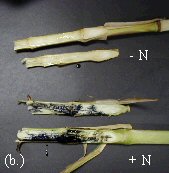
(b.) stalk diphenylamine nitrate test
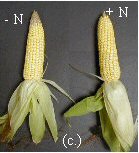
(c.) cob filling
Phosphorus
Phosphorus deficiency will result in stunted weakened seedlings. Leaves and stems will frequently show a purpling or reddening (Figure 13). These symptoms may result from cold wet spring conditions independent of the phosphorus supply. Ears may have irregular rows and twisted ends with underdeveloped kernels and grain will have higher moisture content at harvest.
Phosphorus deficiency will result in stunted weakened seedlings. Leaves and stems will frequently show a purpling or reddening (Figure 13). These symptoms may result from cold wet spring conditions independent of the phosphorus supply. Ears may have irregular rows and twisted ends with underdeveloped kernels and grain will have higher moisture content at harvest.
FIGURE 13 Phosphorus deficiency in corn, with purple tips and leaf margins

Potassium
Potassium deficiency will result in yellowing and drying of leaf margins, especially on older leaves (Figure 14). The plants will be stunted with short internodes. Maturity will be delayed and plants may frequently lodge or blow down late in the growing season. Deficiencies occur most frequently on sandy, organic, wet, or compacted soils.
Potassium deficiency will result in yellowing and drying of leaf margins, especially on older leaves (Figure 14). The plants will be stunted with short internodes. Maturity will be delayed and plants may frequently lodge or blow down late in the growing season. Deficiencies occur most frequently on sandy, organic, wet, or compacted soils.
FIGURE 14 Potassium deficiency in corn starts with the firing of leaf margins on lower leaves
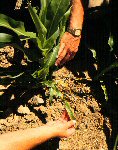

Calcium
Calcium deficiency results in a ladder-like effect with leaf tips stuck to the next lower leaf. Calcium is not deficient in Manitoba soils.
Calcium deficiency results in a ladder-like effect with leaf tips stuck to the next lower leaf. Calcium is not deficient in Manitoba soils.
Magnesium
Magnesium deficiency results in yellowing of upper leaves and intervenal chlorosis of older leaves. Manitoba soils normally contain an adequate amount of magnesium.
Magnesium deficiency results in yellowing of upper leaves and intervenal chlorosis of older leaves. Manitoba soils normally contain an adequate amount of magnesium.
Sulphur
Sulphur deficiency results in a general stunting, delayed maturity, and a yellowing of the new foliage.
Sulphur deficiency results in a general stunting, delayed maturity, and a yellowing of the new foliage.
Zinc
Zinc deficiency results in intervenal chlorosis on new corn leaves. Pale to white bands are evident between the leaf margin and mid-vein in the basal part of the leaf, and under severe deficiencies new leaves emerging from the whorl may be completely white (Figure 15). Zinc deficiency occurs most frequently on high pH, low organic matter soils in years with cold wet springs. High soil phosphorus levels or excess fertilizer phosphorus may induce zinc deficiencies. Zinc deficiencies have been observed in southern Manitoba when soils test below 1.0 ppm DTPA extractable Zn.
Zinc deficiency results in intervenal chlorosis on new corn leaves. Pale to white bands are evident between the leaf margin and mid-vein in the basal part of the leaf, and under severe deficiencies new leaves emerging from the whorl may be completely white (Figure 15). Zinc deficiency occurs most frequently on high pH, low organic matter soils in years with cold wet springs. High soil phosphorus levels or excess fertilizer phosphorus may induce zinc deficiencies. Zinc deficiencies have been observed in southern Manitoba when soils test below 1.0 ppm DTPA extractable Zn.
FIGURE 15 Zinc-deficient corn, with interveinal light striping beginning at the base of younger leaves
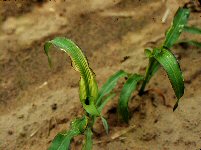

Iron
Iron deficiency causes pale, yellowish-green plants with distinct stripping the full length of the leaf. Symptoms are similar to those of zinc and also occur on high pH, cold, wet soils in the early part of the growing season.
Iron deficiency causes pale, yellowish-green plants with distinct stripping the full length of the leaf. Symptoms are similar to those of zinc and also occur on high pH, cold, wet soils in the early part of the growing season.
Copper
Copper deficiency causes youngest emerging leaves to be yellow and the tips may die. Consider applications of copper when corn is grown on low copper soils (sandy texture, low organic matter, high pH, and DTPA copper levels below 0.4 ppm).
Copper deficiency causes youngest emerging leaves to be yellow and the tips may die. Consider applications of copper when corn is grown on low copper soils (sandy texture, low organic matter, high pH, and DTPA copper levels below 0.4 ppm).
Boron and Molybdenum
These elements are unlikely to be deficient in Manitoba soils.
These elements are unlikely to be deficient in Manitoba soils.
TABLE 10: Corn nutrient sufficiency levels of the ear-leaf sampled at tasselling
| Nutrient | Low | Marginal | Sufficient | High | Excess |
|---|---|---|---|---|---|
| Nitrogen (% N) | 1.9 | 2.0-2.4 | 2.5-3.4 | 3.5-3.9 | 8.0 |
| Phosphorus (% P) | 0.14 | 0.15-0.24 | 0.25-0.49 | 0.5-0.79 | 0.8 |
| Potassium (% K) | 1.2 | 1.3-1.6 | 1.7-2.9 | 3.0-4.9 | 5.0 |
| Calcium (% Ca) | 0.09 | 0.1-0.19 | 0.2-0.99 | 1.0-1.4 | 1.5 |
| Magnesium (% Mg) | 0.09 | 0.1-0.19 | 0.2-0.59 | 0.6-0.99 | 1.0 |
| Sulphur (% S) | 0.09 | 0.1-0.14 | 0.15-0.39 | 0.4-0.79 | 0.80 |
| Iron (ppm Fe) | 14 | 15-19 | 20-249 | 250-499 | 500 |
| Manganese (ppm Mn) | 9 | 10-19 | 20-149 | 150-199 | 200 |
| Copper (ppm Cu) | 2 | 3-5 | 6-19 | 20-49 | 50 |
| Zinc (ppm Zn) | 11 | 12-19 | 20-69 | 70-149 | 150 |
| Boron (ppm B) | 2.9 | 3.0-4.9 | 5-24 | 25-49 | 50 |
| Molybdenum (ppm Mo) | 0.2-19 | ||||
| Criteria used by the form Manitoba Agriculture Provincial Soil Testing Laboratory, 1991. | |||||
Diagnostic Soil and Tissue Sampling
Since visual deficiency symptoms may be similar for various nutrients, proper diagnosis is often dependent upon proper diagnosis through a combination of tissue and soil testing. Sampling of tissue can be done in 2 ways – at a specific growth stage in order to compare to textbook values, or at anytime the symptoms occur and compare suspect vs healthy plants.
To compare nutrient levels to established values, the leaf opposite the cob (called the ear-leaf) should be collected at tasselling from 20-25 plants. Contact your laboratory for instructions on sampling, handling and shipping.
If symptoms are apparent in the young plant, sample 20-25 whole plants in both affected and adjacent good areas. Submit plants and soil samples from the 2 areas separately to the lab. If deficiencies are identified early enough, foliar fertilizer applications may be successful.
Environmental Factors
Drought
Lack of water will cause corn leaves to roll and turn a dull grayish green. In older plants, nitrogen deficiency symptoms may develop. Severe stunting and irregular brown patches of dead leaf tissue may occur (Figure 16).
Lack of water will cause corn leaves to roll and turn a dull grayish green. In older plants, nitrogen deficiency symptoms may develop. Severe stunting and irregular brown patches of dead leaf tissue may occur (Figure 16).
FIGURE 16 Drought effect on small plants
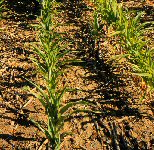
High Temperatures
Drought symptoms that disappear as the temperature drops are caused by high temperatures. These conditions are most common early in the growing season when root development is inadequate. Permanent bleaching and scalding of leaf tissue is uncommon; however, high temperature and drought during pollination can cause sterility and barren ears.
Drought symptoms that disappear as the temperature drops are caused by high temperatures. These conditions are most common early in the growing season when root development is inadequate. Permanent bleaching and scalding of leaf tissue is uncommon; however, high temperature and drought during pollination can cause sterility and barren ears.
Low Temperatures
Low temperatures (5-10°C) can cause "cold banding" on young corn plants. The most common symptom is the appearance of yellow bands across one or more leaves.
Low temperatures (5-10°C) can cause "cold banding" on young corn plants. The most common symptom is the appearance of yellow bands across one or more leaves.
Excess Moisture
Waterlogging will cause young plants to turn yellow and eventually die. Older plants can stand water-logged conditions for a longer period, but they will also become yellow, weak, and susceptible to disease after 1 week.
Waterlogging will cause young plants to turn yellow and eventually die. Older plants can stand water-logged conditions for a longer period, but they will also become yellow, weak, and susceptible to disease after 1 week.
Frost
Freezing temperatures can kill young plants, but frequently only the leaves are killed and plants will recover when the growing point is still beneath the soil surface. Dead upper leaf tissue will be most common in low-lying parts of the field. Frost before maturity can cause death and necrosis of exposed mature plant tissue, thus cutting off the supply of sugars needed to fill the grain (Figure 17).
Freezing temperatures can kill young plants, but frequently only the leaves are killed and plants will recover when the growing point is still beneath the soil surface. Dead upper leaf tissue will be most common in low-lying parts of the field. Frost before maturity can cause death and necrosis of exposed mature plant tissue, thus cutting off the supply of sugars needed to fill the grain (Figure 17).
FIGURE 17 Frost injury on small corn plants
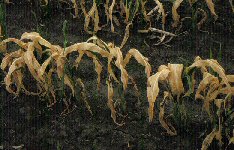
Wind
Seedlings can be directly damaged by wind. Blowing soil particles causing abrasions on leaves and stems and can uproot or break off young plants. Dead or damaged tissue will turn brown and dry up. Shredding of young leaves is frequent. Strong winds following a period of rapid vegetative growth may snap off corn plants at the lower nodes, which is known as ‘green snap. If the plant is severely severed, grain yield will be drastically reduced. Strong winds during grain fill may result in root and stalk lodging (Figure 18).
Seedlings can be directly damaged by wind. Blowing soil particles causing abrasions on leaves and stems and can uproot or break off young plants. Dead or damaged tissue will turn brown and dry up. Shredding of young leaves is frequent. Strong winds following a period of rapid vegetative growth may snap off corn plants at the lower nodes, which is known as ‘green snap. If the plant is severely severed, grain yield will be drastically reduced. Strong winds during grain fill may result in root and stalk lodging (Figure 18).
FIGURE 18 Stalk damage caused by strong winds
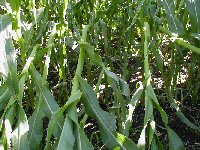
Hail
Damage by hail is easily recognizable by shredded leaves hanging in tatters. If the growing point is still below the soil surface, very little yield loss will be observed. However, if hail occurs later in the vegetative growth stages or during pollination and grain filling periods, yield loss may be significant (Figure 19).
Damage by hail is easily recognizable by shredded leaves hanging in tatters. If the growing point is still below the soil surface, very little yield loss will be observed. However, if hail occurs later in the vegetative growth stages or during pollination and grain filling periods, yield loss may be significant (Figure 19).
FIGURE 19 Hail damage
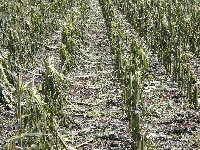
Saline Soils
Plant stands in saline soils will be extremely poor especially in low-lying areas. Seedlings that do emerge will have a generally weak appearance with considerable tip burning and necrosis of lower leaves. Plants will show drought symptoms before those in non-saline parts of the field.
Plant stands in saline soils will be extremely poor especially in low-lying areas. Seedlings that do emerge will have a generally weak appearance with considerable tip burning and necrosis of lower leaves. Plants will show drought symptoms before those in non-saline parts of the field.
Floppy Corn Syndrome
After a period of rapid seedling growth some plants may be observed to be lying on their side, with poor brace-root development, anchored only by the mesocotyl.
After a period of rapid seedling growth some plants may be observed to be lying on their side, with poor brace-root development, anchored only by the mesocotyl.
This may result when corn is seeded shallow and/or the surface soil is hot and dry at the time the plant is developing its nodal or brace roots. Affected plants may not be rooted securely and will fall over in the wind. Plants may be stunted and have a purple appearance. If the planter is improperly set the symptoms may appear over the entire field but are more common where there is a rough, uneven seedbed, cloddy soil or compaction. Inter-row cultivation may assist in encouraging root development (Figure 20).
FIGURE 20 Floppy corn syndrome
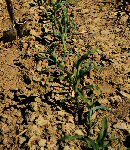
Tall Corn-Short Corn Syndrome
Soil compaction may cause this uneven pattern of crop growth due to impairment of root growth. This may be caused by working the soil when it is too wet, using heavy machinery and seeding into well trafficked areas. Plants may be stunted and purple in colour (Figure 21).
FIGURE 21 Tall/Short corn syndrome



